On the Use of Modern Engineering Codes for Designing a Small Wind Turbine: An Annotated Case Study
Abstract
1. Introduction
2. Methods
2.1. Numerical Tools
2.2. Ideal Blade Shape
2.3. Airfoil Families
2.4. Preliminary Performance Curves
2.5. Modifications to Ideal Design
3. Turbine Control
3.1. Pitch Control
3.2. Stall Control
3.3. Control Input Parameters
4. Simulation Set-Up
5. Results
5.1. Steady-State Performance
5.2. Aerodynamic Performance
5.3. Annual Energy Production (AEP)
5.4. Results in the Time Domain
6. Conclusions
Author Contributions
Funding
Informed Consent Statement
Data Availability Statement
Conflicts of Interest
Appendix A

References
- Veers, P.; Dykes, K.; Lantz, E.; Barth, S.; Bottasso, C.L.; Carlson, O.; Clifton, A.; Green, J.; Green, P.; Holttinen, H.; et al. Grand Challenges in the Science of Wind Energy. Science 2019, 366, eaau2027. [Google Scholar] [CrossRef] [PubMed]
- Gardner, P.; Garrad, A.; Hansen, L.F.; Jamieson, P.; Morgan, C.; Murray, F.; Tindal, A. Wind Energy—The Facts—Part 1: Technology; EWEA: Brussels, Belgium, 2010. [Google Scholar]
- Bukala, J.; Damaziak, K.; Kroszczynski, K.; Malachowski, J.; Szafranski, T.; Tomaszewski, M.; Karimi, H.R.; Jozwik, K.; Karczewski, M.; Sobczak, K. Small Wind Turbines: Specification, Design, and Economic Evaluation. In Wind Turbines—Design, Control and Applications; Aissaoui, A.G., Tahour, A., Eds.; InTech: London, UK, 2016; ISBN 978-953-51-2495-5. [Google Scholar]
- Clausen, P.D.; Reynal, F.; Wood, D.H. Design, manufacture and testing of small wind turbine blades. In Advances in Wind Turbine Blade Design and Materials; Elsevier: Amsterdam, The Netherlands, 2013; pp. 413–431. ISBN 978-0-85709-426-1. [Google Scholar]
- Tzen, E. Small Wind Turbines for on Grid and off Grid Applications. IOP Conf. Ser. Earth Environ. Sci. 2020, 410, 012047. [Google Scholar] [CrossRef]
- Simic, Z.; Havelka, J.G.; Bozicevic Vrhovcak, M. Small Wind Turbines—A Unique Segment of the Wind Power Market. Renew. Energy 2013, 50, 1027–1036. [Google Scholar] [CrossRef]
- EAWE Committees. Available online: https://www.eawe.eu/organisation/committees/ (accessed on 13 January 2021).
- Artal-Sevil, J.S.; Dufo, R.; Dominguez, J.A.; Bernal-Agustin, J.L. Small Wind Turbines in Smart Grids. Transformation of Electrical Machines in Permanent Magnet Synchronous Generators. In Proceedings of the 2018 Thirteenth International Conference on Ecological Vehicles and Renewable Energies (EVER), Monte-Carlo, Monaco, 10–12 April 2018; pp. 1–8. [Google Scholar]
- James, F.M.; Jon, G.M.; Anthony, L.R. Wind Energy Explained: Theory, Design and Application, 2nd ed.; John Wiley & Sons: Hoboken, NJ, USA, 2010; ISBN 978-0-470-01500-1. [Google Scholar]
- Burton, T. (Ed.) Wind Energy Handbook; John Wiley & Sons: Hoboken, NJ, USA, 2001; ISBN 978-0-471-48997-9. [Google Scholar]
- Chaudhary, M.K.; Roy, A. Design & Optimization of a Small Wind Turbine Blade for Operation at Low Wind Speed. World J. Eng. 2015, 12, 83–94. [Google Scholar] [CrossRef]
- IEC. IEC 61400-2. In Wind Turbines—Part 2: Design Requirements for Small Wind Turbines; IEC: Geneva, Switzerland, 2006. [Google Scholar]
- Jacobson, R.; Meadors, M.; Jacobson, E.; Link, H. Power Performance Test Report for the AOC 15/50 Wind Turbine; NREL: Golden, CO, USA, 2003. [Google Scholar]
- Eunice Energy Group (EEG). EW16 THETIS—Wind Turbine 50kw; Eunice Energy Group: Athens, Greece, 2020; p. 10. [Google Scholar]
- Samani, A.E.; de Kooning, J.D.M.; Kayedpour, N.; Singh, N.; Vandevelde, L. The Impact of Pitch-To-Stall and Pitch-To-Feather Control on the Structural Loads and the Pitch Mechanism of a Wind Turbine. Energies 2020, 13, 4503. [Google Scholar] [CrossRef]
- Small Wind Turbine Generators—Tozzi Green. Available online: www.tozzinord.com (accessed on 12 February 2021).
- Drela, M. XFOIL: An Analysis and Design System for Low Reynolds Number Airfoils. In Low Reynolds Number Aerodynamics; Mueller, T.J., Ed.; Springer: Berlin/Heidelberg, Germany, 1989; Volume 54, pp. 1–12. ISBN 978-3-540-51884-6. [Google Scholar]
- Tangler, J.L.; Somers, D.M. NREL Airfoil Families for HAWTs; NREL: Golden, CO, USA, 1995. [Google Scholar]
- Battisti, L.; Zanne, L.; Castelli, M.R.; Bianchini, A.; Brighenti, A. A Generalized Method to Extend Airfoil Polars over the Full Range of Angles of Attack. Renew. Energy 2020, 155, 862–875. [Google Scholar] [CrossRef]
- Drela, M.; Gilest, M.B. Viscous-Inviscid Analysis of Transonic and Low Reynolds Number Airfoils. AIAA J. 1987, 25, 1347–1355. [Google Scholar] [CrossRef]
- OpenFAST. Available online: https://github.com/OpenFAST (accessed on 31 October 2019).
- Jonkman, J.; Butterfield, S.; Musial, W.; Scott, G. Definition of a 5-MW Reference Wind Turbine for Offshore System Development; NREL/TP-500-38060; NREL: Golden, CO, USA, 2009; p. 947422. [Google Scholar]
- Gaertner, E.; Rinker, J.; Sethuraman, L.; Zahle, F.; Anderson, B.; Barter, G.E.; Abbas, N.J.; Meng, F.; Bortolotti, P.; Skrzypinski, W.; et al. IEA Wind TCP Task 37: Definition of the IEA 15-Megawatt Offshore Reference Wind Turbine; NREL/TP-5000-75698; NREL: Golden, CO, USA, 2020; p. 1603478. [Google Scholar]
- Jonkman, J.M.; Hayman, G.J.; Jonkman, B.J.; Damiani, R.R. AeroDyn User’s Guide and Theory Manual; NREL: Golden, CO, USA, 2015. [Google Scholar]
- Manwell, J.F.; McGowan, J.G.; Rogers, A.L. Aerodynamics of Wind Turbines. In Wind Energy Explained: Theory, Design and Application; John Wiley & Sons, Ltd: Chichester, UK, 2010; pp. 91–155. ISBN 978-1-119-99436-7. [Google Scholar]
- Peter, J.S.; Richard, J.C. Wind Turbine Blade Design. Energies 2012, 5, 3425–3449. [Google Scholar]
- Gasch, R.; Twele, J. Wind Power Plants Fundamentals, Design, Construction and Operation, 2nd ed.; Springer: Berlin/Heidelberg, Germany, 2002; ISBN 978-3-642-22938-1. [Google Scholar]
- Atlantic Orient AOC 15/50. Available online: https://it.wind-turbine-models.com/turbines/2164-atlantic-orient-aoc-15-50 (accessed on 12 February 2021).
- Smith, J.; Huskey, A.; Jager, D.; Hur, J. Duration Test Report for the Entegrity EW50 Wind Turbine; NREL: Golden, CO, USA, 2012. [Google Scholar]
- E-3120 50kW Wind Turbine. Available online: http://www.burnley.gov.uk/attachments/12_0055_Appendix_Endurance_E-3120_turbine_specifications.pdf (accessed on 12 February 2021).
- Mamadaminov, U.M. Review of Airfoil Structure for Wind Turbine Blades. Or. Inst. Technol. 2013, Energy Engineering I, 1–8. [Google Scholar]
- Fuglsang, P.; Bak, C. Development of the Risø wind turbine airfoils. Wind Energy Int. J. Prog. Appl. Wind Power Convers. Technol. 2004, 7, 145–162. [Google Scholar] [CrossRef]
- Timmer, W.A.; Van Rooij, R.P.J.O.M. Summary of the Delft University Wind Turbine Dedicated Airfoils. J. Sol. Energy Eng. 2003, 125, 488–496. [Google Scholar] [CrossRef]
- Somers, D.M. Design and Experimental Results for the S805 Airfoil; NREL: Golden, CO, USA, 1997. [Google Scholar]
- Somers, D.M. The S819, S820 and S821 Airfoils: October 1992–November 1993; NREL: Golden, CO, USA, 2005. [Google Scholar]
- Tangler, J.L.; NREL; Somers, D.M.; Airfoils, Inc. Airfoils for Wind Turbine; NREL: Golden, CO, USA, 1996. [Google Scholar]
- Griffin, D.A.; Lynette, R. Investigation of Aerodynamic Braking Devices for Wind Turbine Applications; NREL: Golden, CO, USA, 1997. [Google Scholar]
- Islam, M.R.; Bashar, L.B.; Saha, D.K.; Rafi, N. Comparison and Selection of Airfoils for Small Wind Turbine between NACA and NREL’s S series Airfoil Families. Int. J. Res. Electr. Electron. Commun. Eng. 2019, 4, 1–12. [Google Scholar]
- Ramsay, R.R.; Hoffmann, M.J.; Gregorek, G.M. Effects of Grit Roughness and Pitch Oscillations on the S812 Airfoil: Airfoil Performance Report, Revised (12/99); Ohio State University: Columbus, OH, USA, 1999. [Google Scholar]
- Ramsay, R.R.; Gregorek, G.M. Effects of Grit Roughness and Pitch Oscillations on the S813 Airfoil: Airfoil Performance Report, Revised (12/99); Ohio State University: Columbus, OH, USA, 1996. [Google Scholar]
- Somers, D.M.; Tangler, J.L. Wind-Tunnel Test of the S814 Thick-Root Airfoil; NREL: Golden, CO, USA, 1995. [Google Scholar]
- Dal Monte, A.; de Betta, S.; Castelli, M.R.; Benini, E. Proposal for a coupled aerodynamic—Structural wind turbine bladeoptimization. Compos. Struct. 2017, 159, 144–156. [Google Scholar] [CrossRef]
- Hansen, M.O.L. Aerodynamics of Wind Turbines, 2nd ed.; Earthscan: London, UK; Sterling, VA, USA, 2008; ISBN 978-1-84407-438-9. [Google Scholar]
- Shen, W.Z.; Zhu, W.J.; Sørensen, J.N. Study of Tip Loss Corrections Using CFD Rotor Computations. J. Phys. Conf. Ser. 2014, 555, 012094. [Google Scholar] [CrossRef]
- Himmelskamp, H. Profiluntersuchungen an Einem Umlaufenden Propeller; Report No 1945; Diss. Goettingen; Max-Planck-Inst. fuer Stroemungsforschung: Goettingen, Germany, 1950. [Google Scholar]
- Hand, M.M.; Simms, D.A.; Fingersh, L.J.; Jager, D.W.; Cotrell, J.R.; Schreck, S.; Larwood, S.M. Unsteady Aerodynamics Experiment Phase VI: Wind Tunnel Test Configurations and Available Data Campaigns; NREL/TP-500-29955; NREL: Golden, CO, USA, 2001; p. 15000240. [Google Scholar]
- Bak, C. Three-Dimensional Corrections of Airfoil Characteristics Based on Pressure Distributions. In Proceedings of the European Wind Energy Conference, Athens, Greece, 27 February–2 March 2006. [Google Scholar]
- Abbas, N.J.; Wright, A.; Pao, L. An Update to the NREL Baseline Wind Turbine Controller. Renew. Energy 2020, 17, Preprint. [Google Scholar]
- Mulders, S.P.; van Wingerden, J.W. Delft Research Controller: An open-source and community-driven wind turbine baseline controller. J. Phys. Conf. Ser. 2018, 1037, 032009. [Google Scholar] [CrossRef]
- Muljadi, E.; Pierce, K.; Migliore, P. A conservative control strategy for variable-speed stall-regulated wind turbines. In Proceedings of the 2000 ASME Wind Energy Symposium, Reno, NV, USA, 10–13 January 2000. [Google Scholar]
- Wright, A.D.; Fingersh, L.J. Advanced Control Design for Wind Turbines Part I: Control Design, Implementation, and Initial Tests; NREL: Golden, CO, USA, 2008. [Google Scholar]
- ROSCO Tollbox, Version 1.0.0. GitHub Repository. GitHub: San Francisco, CA, USA, 2020.
- Li, D.; Chen, C. Comparison of Energy Efficiency between Fixed-speed and Variable-speed Wind Turbines. Energy Eng. 2009, 101, 71–80. [Google Scholar] [CrossRef]
- Jonkman, J.M.; Buhl, M.L., Jr. FAST User’s Guide; NREL: Golden, CO, USA, 2005. [Google Scholar]
- Hansen, M.H.; Thomsen, K.; Natarajan, A.; Barlas, A. Design Load Basis for Onshore Turbines. In DTU Wind Energy Technical Report; Department of Wind Energy: Roskilde, Denmark, 2015. [Google Scholar]
- Bortolotti, P.; Canet, H.; Bottasso, C.L.; Loganathan, J. Performance of Non-Intrusive Uncertainty Quantification in the Aeroservoelastic Simulation of Wind Turbines. Wind Energy Sci. 2019, 4, 397–406. [Google Scholar] [CrossRef]
- Bardala, L.M.; Sætrana, L.R. Influence of turbulence intensity on wind turbine power curves. Energy Procedia 2017, 137, 553–558. [Google Scholar] [CrossRef]
- Kaiser, K.; Langreder, W.; Hohlen, H.; Højstrup, J. Turbulence Correction for Power Curves. In Wind Energy; Springer: Berlin/Heidelberg, Germany, 2007. [Google Scholar]
- Albers, A.; Jakobi, T.; Rolf, R.; Stoltenjohannes, J. Influence of meteorological variables on measured wind turbine power curves. In Proceedings of the European Wind Energy Conference & Exhibition, Milan, Italy, 7–10 May 2007. [Google Scholar]
- Wagner, R.; Courtney, M.; Larsen, T.J.; Paulsen, U.S. Simulation of Shear and Turbulence Impact on Wind Turbine Performance; Danmarks Tekniske Universitet, Risø Nationallaboratoriet for Bæredygtig Energi: Roskilde, Denmark, 2010. [Google Scholar]


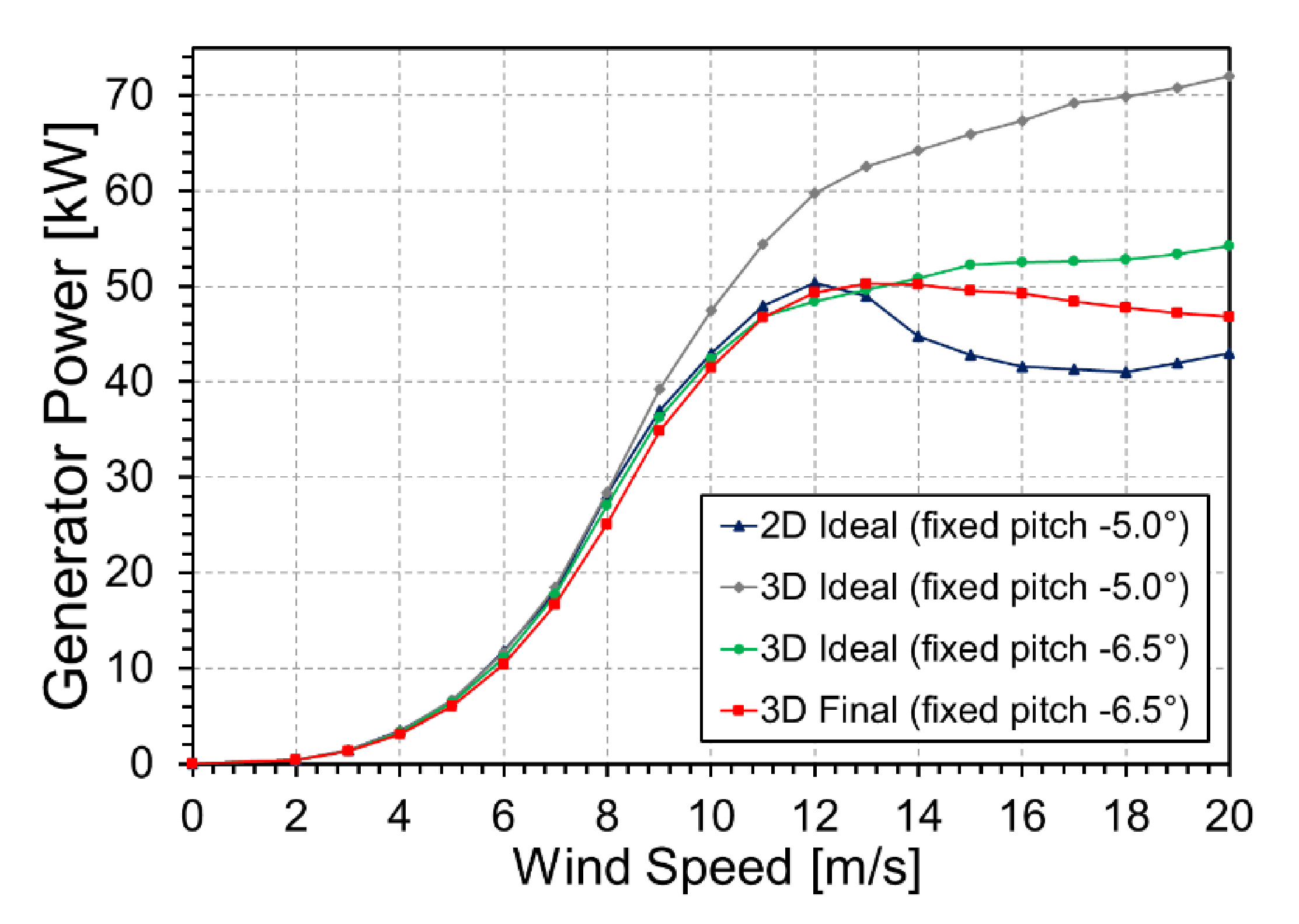


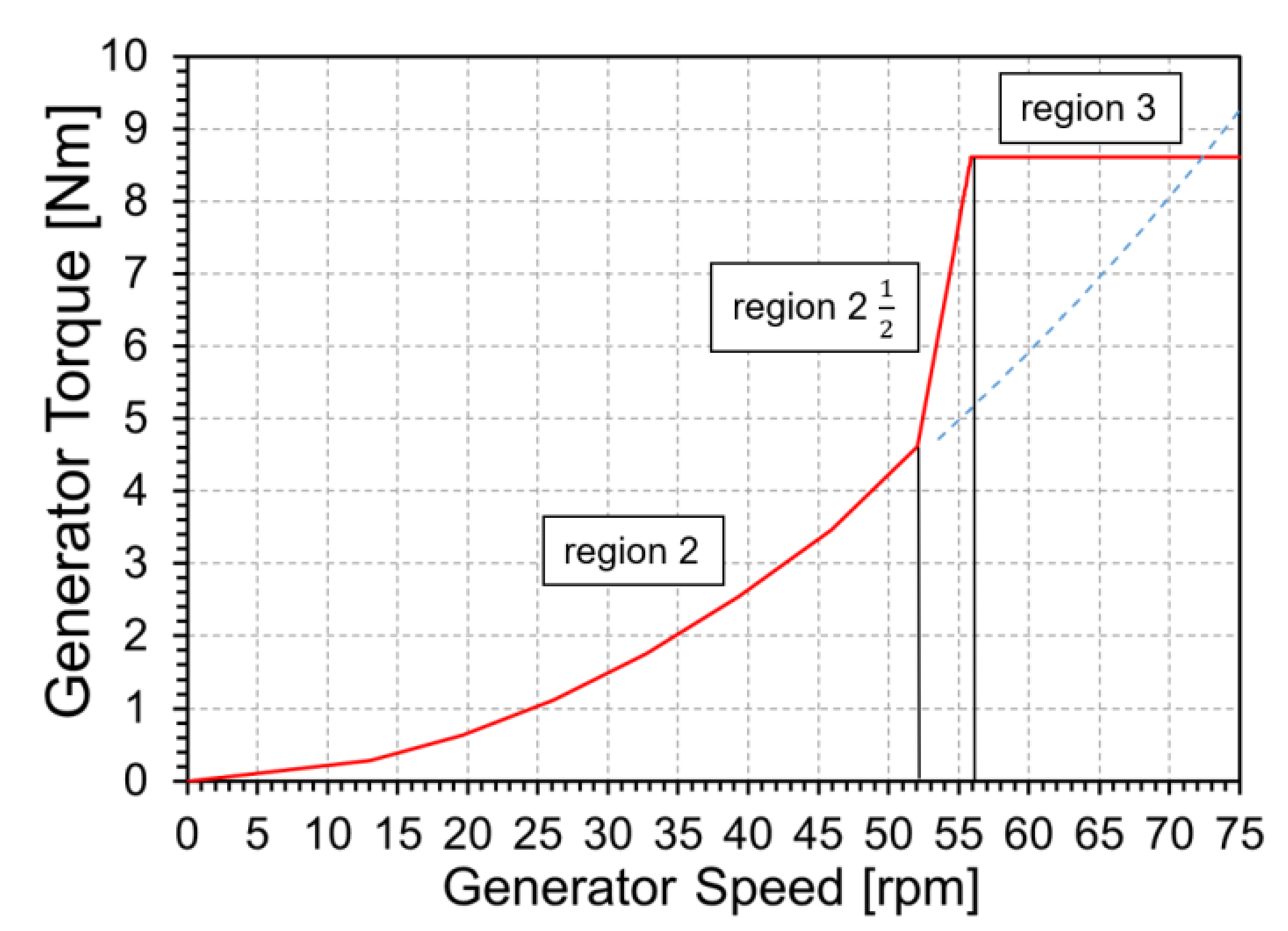
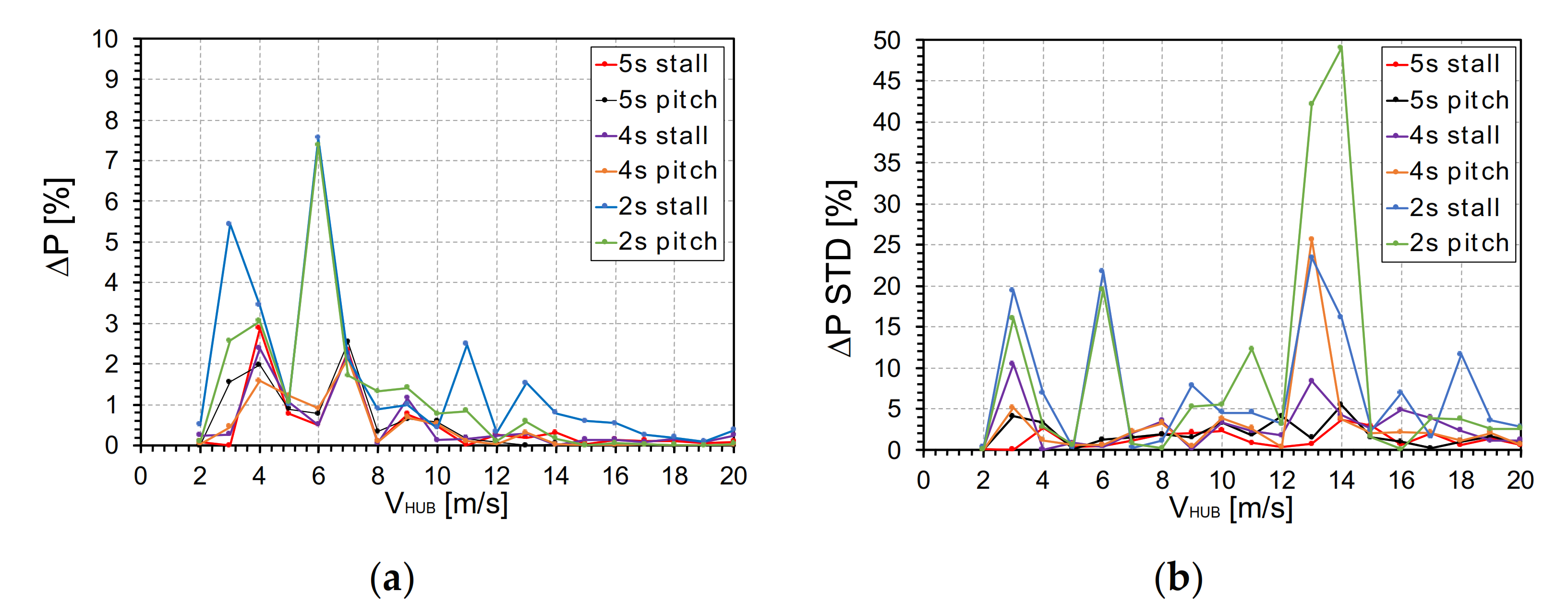
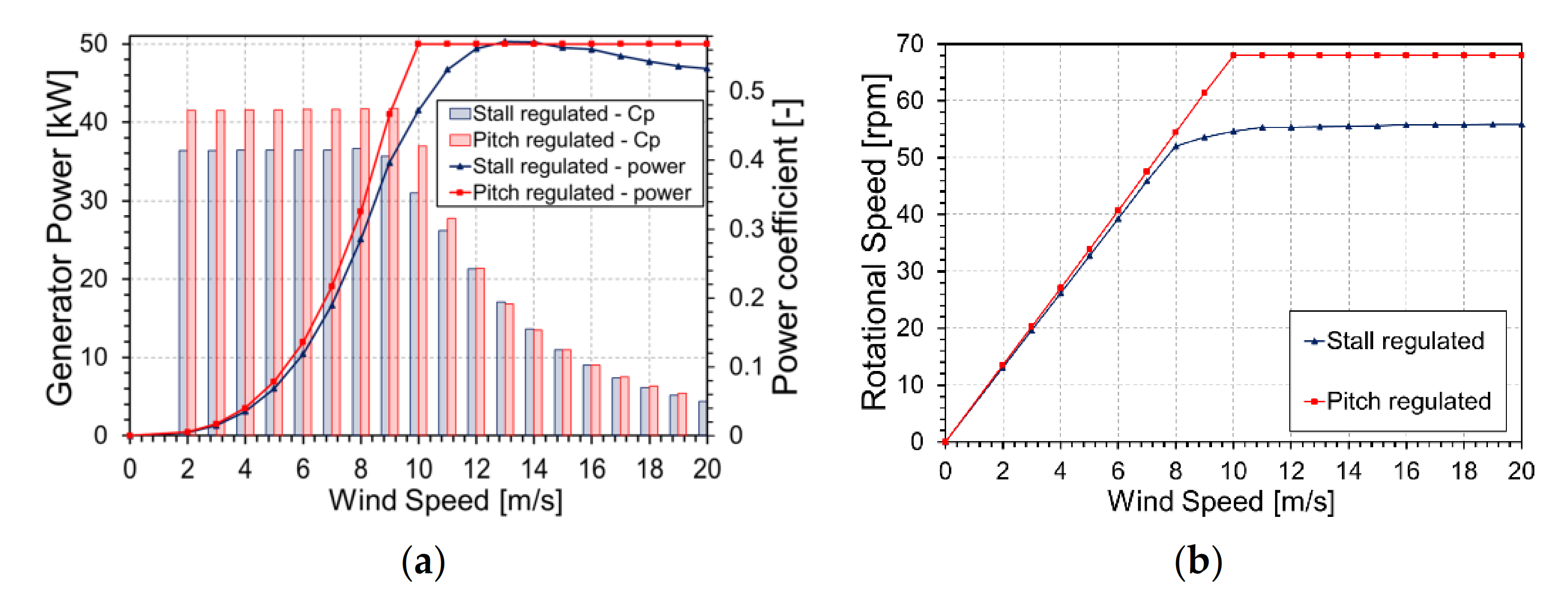

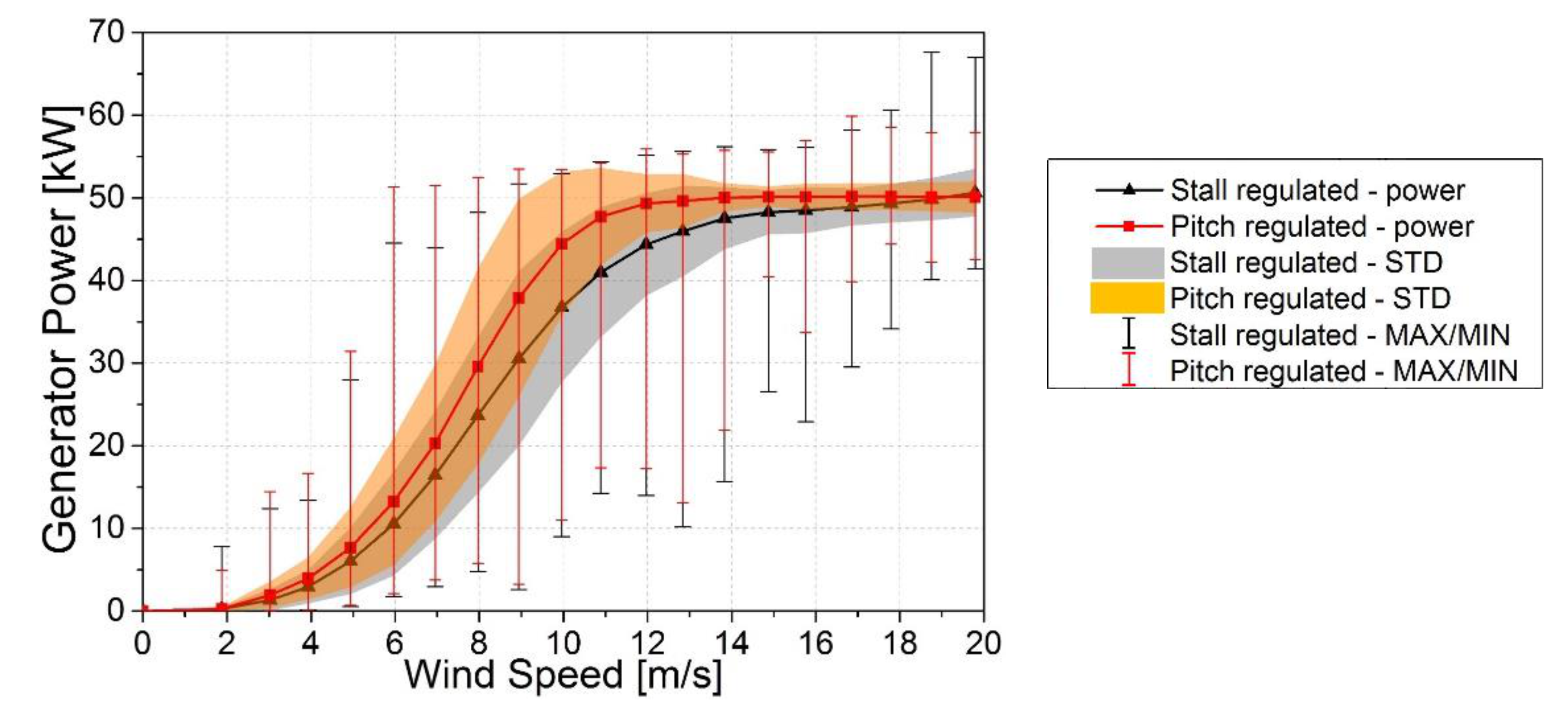
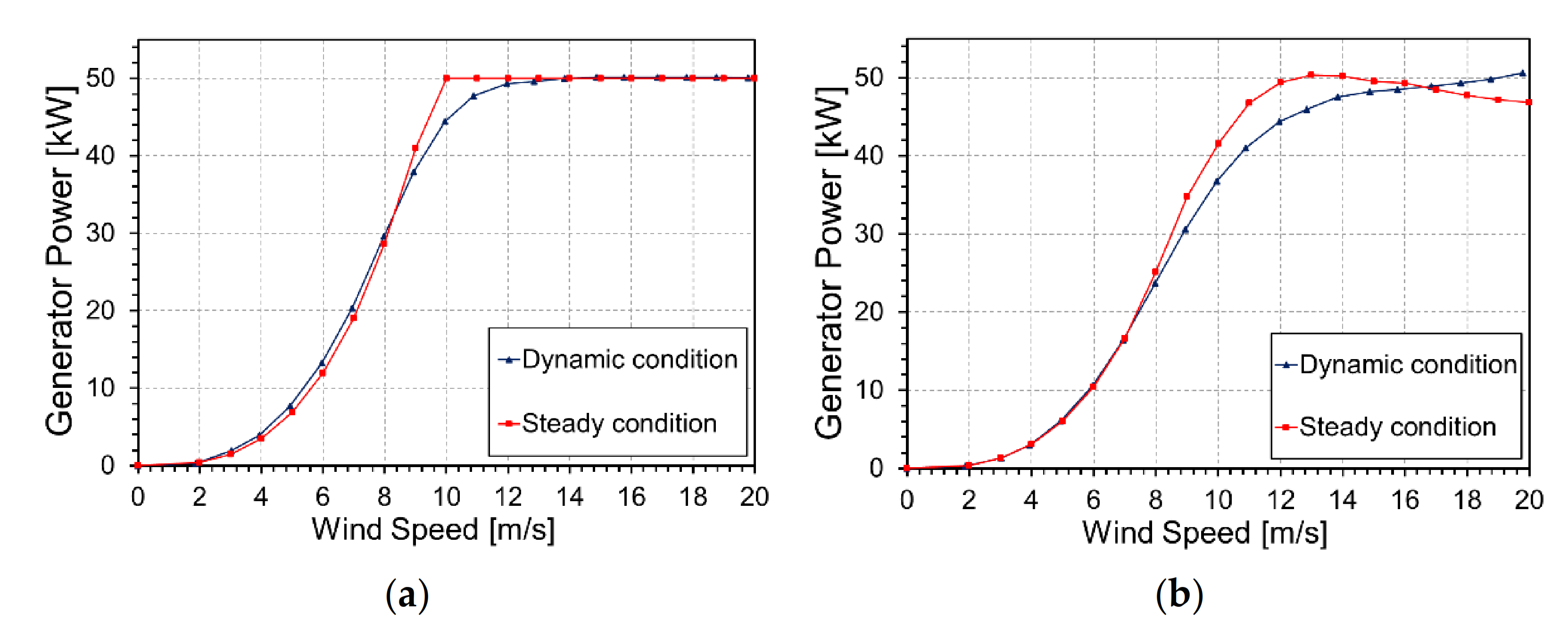
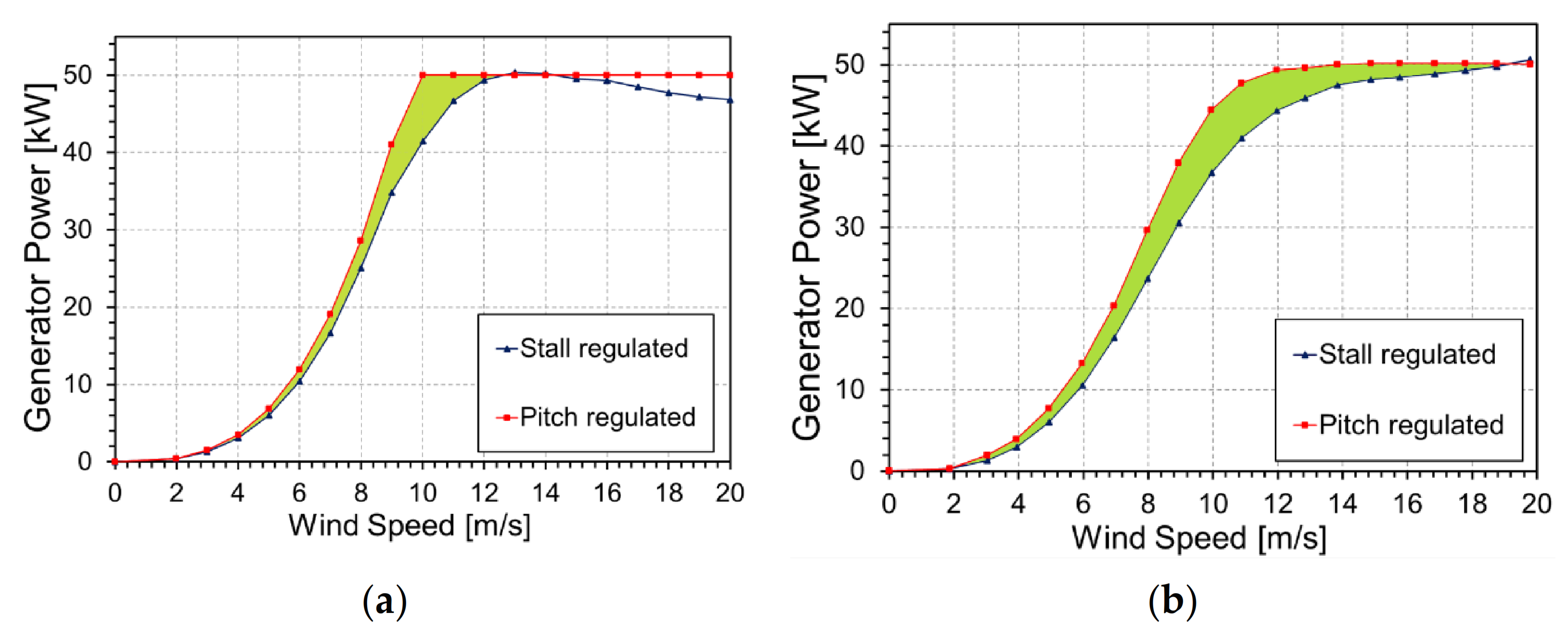

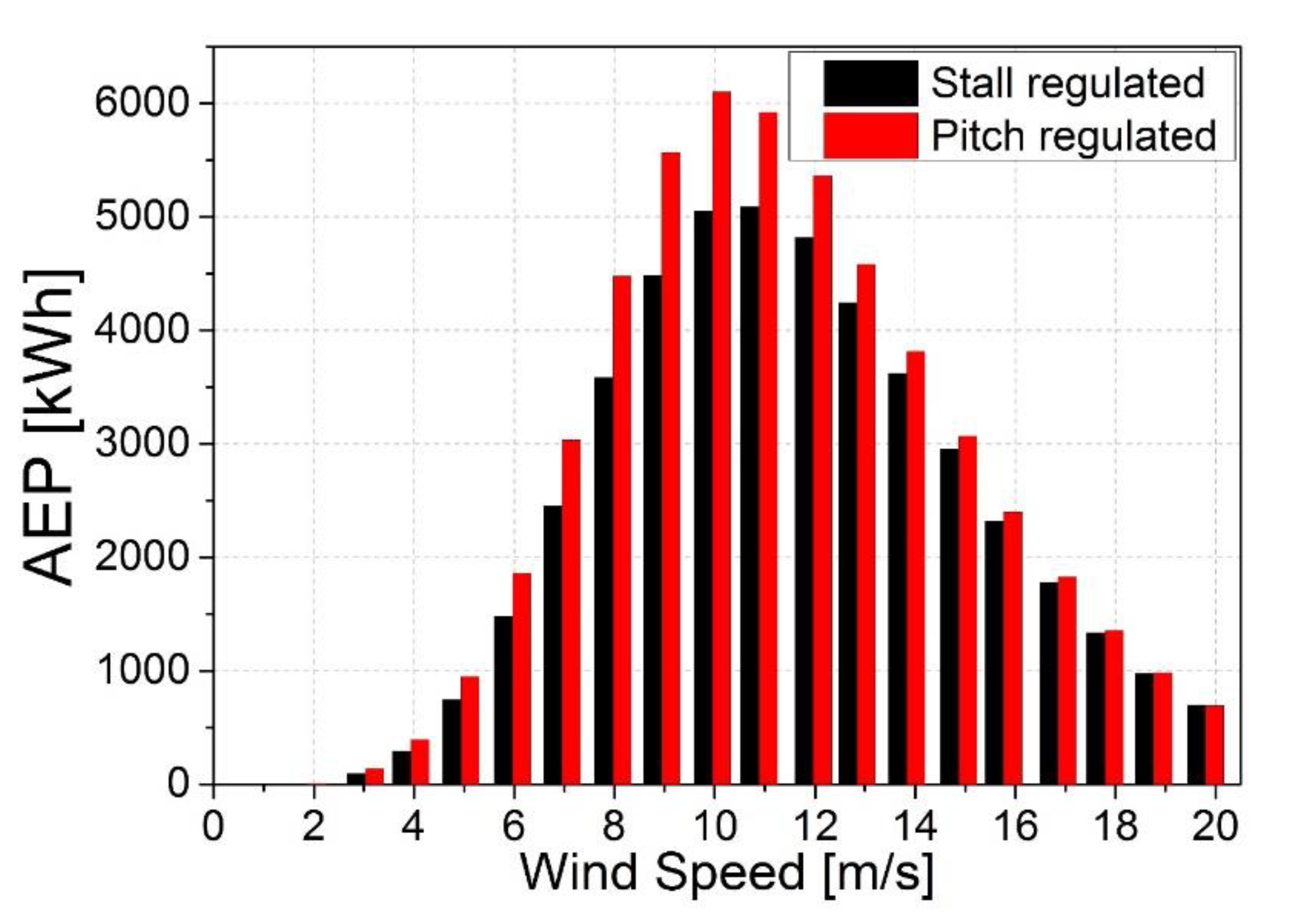


| Parameter | Value |
|---|---|
| IEC wind class | IIA |
| Rotation axis | Horizontal |
| Number of blades | 3 |
| Rotor diameter | 16 m |
| Hub radius | 0.5 m |
| Rated Power | 50 kW |
| Cut-in/cut-out wind speed | 2–20 m/s |
| Rated wind speed | 12 m/s |
| Hub height | 20.5 m |
| Airfoil family | NREL S821-19-20 |
| Parameter | Stall-Regulation | Pitch-Regulation |
|---|---|---|
| Rated generator speed | 60 rpm | 68 rpm |
| Rated generator torque | 12,878.58 Nm | 7727.02 Nm |
| K (see Equation (7)) | 1.645 Nm/ | 1.694 Nm/ |
| Slip % in region 2½ | 26% | n/a |
| Parameter | Value |
|---|---|
| Type of Evaluation | Fatigue/Ultimate |
| Simulation Length | 600 s |
| Number of Simulations per W.S. and Yaw Angle | 3 |
| Wind Speeds | 2–20 m/s increments of 1 m/s |
| Yaw Angles | 0/+8/−8 deg |
| Vertical Inflow Angle | 8 deg |
| Total Number of Simulations | 228 |
| Total Simulated Time | 38 h |
| Speeds per WS | 6 | 5 | 4 | 2 |
|---|---|---|---|---|
| AEP stall | 46.06 | 46.11 | 46.22 | 46.32 |
| ΔAEP (%) stall | - | 0.117 | 0.345 | 0.575 |
| AEP pitch | 52.55 | 52.69 | 52.65 | 52.53 |
| ΔAEP (%) pitch | - | 0.251 | 0.176 | 0.040 |
Publisher’s Note: MDPI stays neutral with regard to jurisdictional claims in published maps and institutional affiliations. |
© 2021 by the authors. Licensee MDPI, Basel, Switzerland. This article is an open access article distributed under the terms and conditions of the Creative Commons Attribution (CC BY) license (http://creativecommons.org/licenses/by/4.0/).
Share and Cite
Papi, F.; Nocentini, A.; Ferrara, G.; Bianchini, A. On the Use of Modern Engineering Codes for Designing a Small Wind Turbine: An Annotated Case Study. Energies 2021, 14, 1013. https://doi.org/10.3390/en14041013
Papi F, Nocentini A, Ferrara G, Bianchini A. On the Use of Modern Engineering Codes for Designing a Small Wind Turbine: An Annotated Case Study. Energies. 2021; 14(4):1013. https://doi.org/10.3390/en14041013
Chicago/Turabian StylePapi, Francesco, Alberto Nocentini, Giovanni Ferrara, and Alessandro Bianchini. 2021. "On the Use of Modern Engineering Codes for Designing a Small Wind Turbine: An Annotated Case Study" Energies 14, no. 4: 1013. https://doi.org/10.3390/en14041013
APA StylePapi, F., Nocentini, A., Ferrara, G., & Bianchini, A. (2021). On the Use of Modern Engineering Codes for Designing a Small Wind Turbine: An Annotated Case Study. Energies, 14(4), 1013. https://doi.org/10.3390/en14041013









